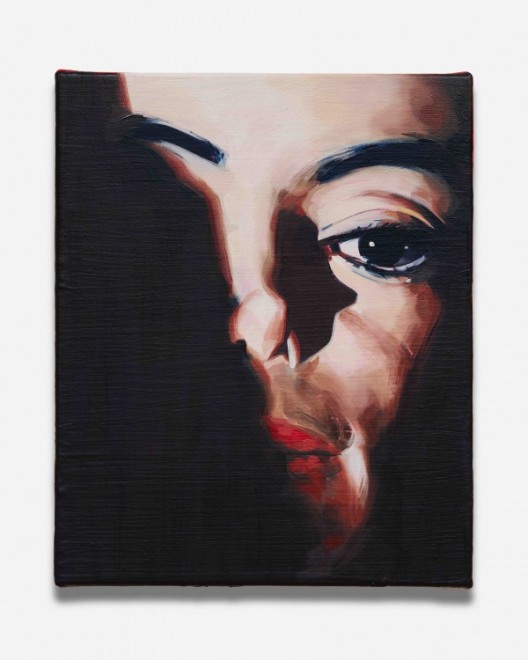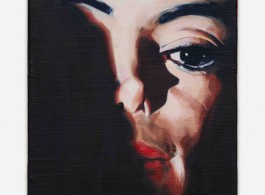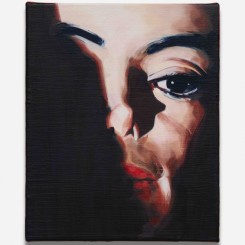Neverland
Almine Rech Brussels

Sam McKinniss, Michael, 2018 – Oil over acrylic on canvas – 25,4 x 20,3 cm, 10 x 8 inches / © Sam McKinniss – Courtesy of the Artist and Almine Rech – Photo: Matt Kroening
Almine Rech is pleased to present ‘Neverland’, the first solo show by the Brooklyn-based painter Sam McKinniss with the gallery.
Once upon a time, painting died. Hers was not a tragic death, she faded slowly—sputtering and flickering into her goodnight, shrouded in myth. While the whole story is terribly complicated, it boils down to the tale of a maiden whose life-force was eclipsed by a new-fangled monster: photography. Oh! These scopophilic arts—painting and her evil stepchild, photography. Cut of the same cloth, or so we thought, these endeavors were developed in order to fulfill the human desire to capture and fix images, to tell stories visually, to represent, fantasize, or enhance what reality looks like.
As legend has it, painting and photography profited from an early, mutually beneficial alliance before the hierarchies determining their dynamic and relation to power dramatically shifted. And so, by the final quarter of the twentieth century, painting was demoted in deference to the ruthless, modern marvel of the camera. Despite her ancient alchemy, painting seemed no match for the photomechanical. But just like all fairytales or soap operas, no one ever really dies. Renewal, rebirth, rehab…it’s all just part and parcel to the genre.
Fast forward to the 1990’s. Painting had arisen from her tomb, suddenly, her eternal spirit summoned by a cadre of artists that dared to put oil to canvas. Ditching their cameras, these anachronistic fetishists instead painted from photographs. But if “Painting is painting’s favorite food,” as the wise Asger Jorn once said, it must have been that nobody had any paintings to snack on. Rather than starve, these artists looted the cookie jars of mass media: People, The New York Post, SPIN magazine, and other sundry tabloids. Elizabeth Peyton stood out among these new heroes as a sorceress who could conjure paint’s mystical charms and historical pedigree, infusing it with new life, painting the world of supermarket celebrity. She invented a phantasmagorical pantheon of modern and personal life, rendered in glamourous jewel tones on small panels by her own hand. “Authentic” painting was rehabilitated and everyone once again worshiped at the altar of the icon without any qualms.
Then the internet happened. A twenty-first century figure, Sam McKinniss was spared all the drama of centuries past. Liberated from these historical squabbles around painting’s primacy or lack of legitimacy, he came of age as an artist with unfettered relationships to his medium and celebrity worship, enabled by this other monster called “Google.” If portraiture has always been about POWER then McKinniss is the first artist since Peyton to convincingly merge “the singularity, preciousness, and longevity of the painted picture”[1] with the ephemeral celebrity
of his subjects, creating an oil-on-canvas fairytale of our present age.
For those who might not see an important generational shift at play—for again, like any mythologized narrative, there must be a mortal rivalry—McKinniss slays his predecessor with an unromantic embrace of media familiar to Peyton, overtaken in spite of love, sentimentality, heroism, or what have her. Harkening forth the spirit of Weimar Germany, McKinniss has emerged as a neo-Magical Realist, combining “the actual and the uncanny,”[2] transfiguring the reality of the internet age—its starry firmament peopled by the likes of Michael Jackson, or Madonna, or Jennifer Lopez wearing the very gown that launched a million or more Google Image searches—into his depiction of our contemporary “Neverland.”
[1] Isabelle Graw, The Love of Painting: Genealogy of a Success Medium (Berlin: Sternberg Press, 2018)
[2] Matthew Gale and Katy Wan, Magic Realism: Art in Weimar Germany 1919-33 (London: Tate Publishing, 2018)
- Alison Gingeras


